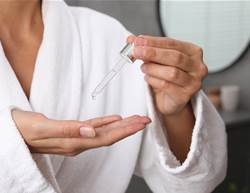Every Autumn, my face becomes a desert the first day that temperatures drop below 20 degrees. Bits of dry skin flake off my cheeks like tumbleweeds, and my daily moisturiser is powerless to do anything about it. So begins a months-long battle that lasts until spring, when humidity finally returns to the air and my skin heals on its own. This year, though, I vowed not to admit defeat and optimistically turned to oils. I'd never tried oils before for fear they'd wreak havoc on my acne-prone skin, so I spoke with dermatologist Dr Janet Prystowsky, to get the DL on this practice that even oily skin-types are raving about.
According to Prystowsky, facial moisturisers like the one I'd been using are misleading because they actually have very little moisturising benefit. Lotion moisturisers are mostly water, and they don't contain any ingredients that prevent water from evaporating from the skin she explains. Thick creams and oils work better she said, because they don't contain water, and instead create a barrier on the skin that keeps water from escaping. For this reason, the best time to apply an oil is after cleansing to seal in the water that has just been absorbed.
My skin-type falls into the confusing category of combination skin-chin and nose an oil slick, cheeks and forehead a desolate wasteland. When I voiced my fears of triggering acne to Prystowsky, she gave me some practical but game-changing advice: "Only apply the oil to areas where you need it. She said it's true oil could aggravate the acne on my chin, but I probably don't need any moisture there to begin with. Having absorbed this advice, I set out to try a bunch of popular oils until I found the perfect candidate. Here's how it went:






Coconut Oil
The first couple of times I put coconut oil on my face it didn't sink in for hours. Which brings me immediately to the most important thing I learned about moisturising with oil: Only use half of what you think you need. It's easy to go overboard with oil because it covers a lot more ground than a comparable amount of lotion, and it doesn't usually come in convenient pump bottles that make it easy to measure how much you're using.
Still, even a tiny amount of coconut oil felt heavy on my skin and left it feeling greasy for longer than is comfortable. Plus, my face didn't feel especially hydrated after a few days of using it, and I still had some dry, rough patches on my cheeks. I decided to save the rest of my jar for cooking and move on.
Rosehip Oil
I know I just said I prefer unscented moisturisers for the face, but I'll make an exception for rosehip. It has a soothing, subtle herbal scent that reminds me of my favourite bedtime chamomile tea blend. Rosehip is a drier oil, absorbing quickly for a matte finish, so I had no fears about it triggering a breakout. My skin was definitely smoother and cleaner-looking after a couple days.
Sunflower Oil
Organic sunflower oil might be tricky to find in your local grocery store, but it's one of Prystowsky's favourites for treating eczema and dry skin, because it closely mimics the skin's natural sebum. It's a lighter oil and the odour is completely neutral, which I appreciated because I don't like a lot of fragrance around my face. I used a cotton ball to apply the oil to make sure I didn't overdo it. While it did feel greasy for a bit, it wasn't nearly as heavy as coconut oil, and my face was noticeably softer the next day.
Jojoba Oil
Jojoba oil is sometimes recommended as a great option for moisturising oily skin, so I was excited to give it a go. I tried Jojoba Oil and found it similar to sunflower oil in that it was light and scent-free. It didn't sit on top of my skin for too long and did a good job at fighting flakiness. I did experience some annoying chin acne while I was using jojoba, but I'm not certain it was due to the oil. Overall, jojoba was a positive experience.
Olive Oil
Olive oil is somewhere between coconut and jojoba in terms of thickness. I applied some with a cotton ball before bed, and it took awhile for it to absorb fully. The next day my skin felt great, but I'd be nervous about using it daily because it has a reputation for clogging pores.
Conclusion
I'll definitely keep using the rosehip oil as part of my daily nighttime routine. Once a week or so, I plan to use jojoba or sunflower oil for a deeper moisturisation. So far, my skin has never looked better after a week of cold, dry, windy weather!
This story was originally published by our partners at RodalesOrganicLife.com.










